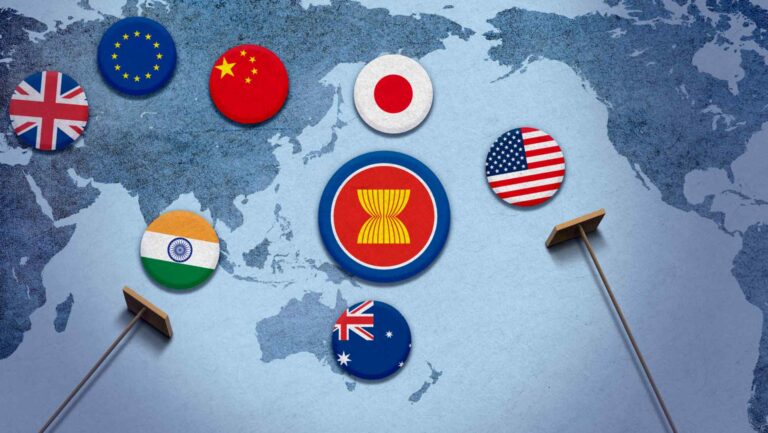The Climate-Debt Dilemma Facing the Indo-Pacific SIDS – orfonline.org

Report on the Climate-Debt Dilemma and Sustainable Development in Indo-Pacific SIDS
Introduction: A Dual Crisis Threatening the Sustainable Development Goals
Small Island Developing States (SIDS) in the Indo-Pacific are confronting a dual crisis of unsustainable sovereign debt and acute climate vulnerability. This situation poses a significant threat to their ability to achieve the 2030 Agenda for Sustainable Development. The case of the Maldives, which faces an extremely high risk of debt default, mirrors the recent crisis in Sri Lanka and highlights systemic challenges that impede progress on key Sustainable Development Goals (SDGs), particularly SDG 1 (No Poverty), SDG 8 (Decent Work and Economic Growth), and SDG 13 (Climate Action). The convergence of weak fiscal management, high external borrowing, and vulnerability to external shocks creates a precarious environment for these nations.
Analysis of Debt and Climate Vulnerabilities
Unsustainable Debt and its Impact on Economic Stability (SDG 8)
A majority of the 18 SIDS in the Indo-Pacific are experiencing significant debt distress, with 11 classified in critical risk categories by the IMF and World Bank. Escalating debt-to-GDP ratios, exacerbated by the COVID-19 pandemic, severely constrain public finances and undermine efforts to foster sustainable economic growth as outlined in SDG 8. The primary causal factors include:
- Weak fiscal management and inadequate policy responses.
- Extensive external borrowing, often on commercial terms with high interest rates due to their ‘middle-income’ status, which limits access to concessional financing.
- Depletion of foreign exchange reserves.
- Inherent structural challenges such as a lack of economic diversification, high import dependency, and geographical limitations.
This financial fragility directly compromises the capacity of SIDS to invest in social programs and poverty eradication, thereby threatening SDG 1 (No Poverty).
Acute Climate Vulnerability and the Imperative for Climate Action (SDG 13)
Despite contributing less than 1% of global greenhouse gas emissions, Indo-Pacific SIDS are among the nations most severely affected by the climate crisis. All 18 SIDS in the region rank highly on the Notre Dame Global Adaptation Initiative (ND-GAIN) index for exposure to climate change, with the Maldives being the most vulnerable. This reality underscores the urgent need for global and local efforts to achieve SDG 13 (Climate Action). The high cost of climate adaptation, which includes investments in resilient infrastructure (SDG 9) and building fiscal buffers for recovery, is a major challenge. The small populations and economies of SIDS prevent economies of scale, forcing them into a vicious cycle where they must borrow at high costs to finance climate resilience, further exacerbating their debt burden.
A Global Partnership for Sustainable Solutions: The Antigua and Barbuda Accord
A Framework for Resilience and Sustainable Development (SDG 17)
The Antigua and Barbuda Accord (2024–2034), adopted at the 4th UN International Conference on SIDS, represents a critical global partnership (SDG 17) to build resilience and promote sustainable development. A central element of this accord is the establishment of the Global SIDS Debt Sustainability Support Service (DSSS), designed to break the cycle of debt and create fiscal space for climate and development investments.
Key Mechanisms of the DSSS
The DSSS aims to provide multi-layered support through several innovative mechanisms that align with the SDGs:
- Innovative Debt Relief and Financing: The service promotes the use of contingent debt clauses (debt suspension during shocks), parametric insurance, and debt swaps. Debt-for-nature and debt-for-climate swaps, as successfully implemented by Seychelles with its blue bonds, offer a direct pathway to reduce debt while funding projects that support SDG 14 (Life Below Water) and SDG 13 (Climate Action).
- Enhanced Creditor Coordination: A major obstacle in sovereign debt restructuring is the lack of coordination among diverse creditors. The DSSS aims to facilitate timely and fair restructuring processes, which is essential for creating stable institutions and governance under SDG 16 (Peace, Justice and Strong Institutions).
- Promoting the Multidimensional Vulnerability Index (MVI): The DSSS advocates for the use of the MVI over traditional income-based metrics. This shift would provide a more accurate assessment of the structural vulnerabilities of SIDS, helping to address systemic inequities in the global financial architecture and advance SDG 10 (Reduced Inequalities) by enabling more appropriate access to concessional financing.
Conclusion and Key Takeaways for the 2030 Agenda
The intertwined debt and climate crises facing Indo-Pacific SIDS demand a coordinated and multi-layered response from the international community. Failure to act could trigger further defaults, with significant regional and global repercussions, and derail progress towards the Sustainable Development Goals.
- Critical Juncture for SIDS: The amplified vulnerabilities post-COVID-19 place SIDS at a critical point where further shocks could lead to a severe setback in achieving the 2030 Agenda.
- Addressing the “Financial Grey Zone”: SIDS are often considered too “wealthy” for concessional aid but too “risky” for affordable market finance. This gap must be bridged with new forms of financing, as envisioned in the Antigua and Barbuda Accord, to support investment in resilient infrastructure (SDG 9) and sustainable communities (SDG 11).
- The Imperative of Partnership: A multi-stakeholder approach, as championed by SDG 17, is essential. Implementing effective, economically viable, and mutually beneficial solutions requires coordinated action from SIDS governments, international financial institutions, and public and private creditors.
Analysis of SDGs, Targets, and Indicators
1. Which SDGs are addressed or connected to the issues highlighted in the article?
The article discusses a complex interplay of economic distress and climate vulnerability in Small Island Developing States (SIDS), directly connecting to several Sustainable Development Goals (SDGs). The following SDGs are addressed:
- SDG 8: Decent Work and Economic Growth – The article’s core focus on debt crises, unsustainable debt-to-GDP ratios, weak fiscal management, and lack of economic diversification in SIDS like the Maldives and Sri Lanka directly relates to the goal of achieving sustainable economic growth.
- SDG 9: Industry, Innovation and Infrastructure – The need for SIDS to make “investments into resilient physical infrastructure” to cope with climate change is explicitly mentioned, linking the discussion to the development of sustainable and resilient infrastructure.
- SDG 13: Climate Action – This is a central theme, as the article highlights that SIDS are “the most affected by the climate crisis” and face an “urgent need to invest in climate change adaptation.” The discussion revolves around their high climate vulnerability and the need for resilience-building measures.
- SDG 14: Life Below Water – The article provides the example of Seychelles’ “success with debt-for-nature swaps and blue bonds,” which are innovative financing mechanisms that link debt relief to the conservation and sustainable use of marine resources.
- SDG 17: Partnerships for the Goals – The entire article underscores the importance of global partnerships. It discusses the roles of the IMF, World Bank, and the UN; the need for international financial support; the Antigua and Barbuda Accord as a framework for coordinated efforts; and the critical challenge of “creditor coordination” in debt restructuring processes.
2. What specific targets under those SDGs can be identified based on the article’s content?
Based on the issues discussed, several specific SDG targets can be identified:
- Target 8.1: Sustain per capita economic growth. The article’s focus on escalating debt-to-GDP ratios and the risk of economic default in SIDS directly threatens the sustainability of their economic growth.
- Target 9.a: Facilitate sustainable and resilient infrastructure development in SIDS through enhanced financial support. The article highlights that a major constraint for SIDS is financing the “massive public investments needed for such adaptation” and discusses new financing mechanisms to address this gap.
- Target 13.1: Strengthen resilience and adaptive capacity to climate-related hazards. The article emphasizes that SIDS have “significantly high levels of climate vulnerability” and that building “climate adaptation and resilience” is a pressing need.
- Target 13.a: Implement the commitment to mobilize financial resources to address the needs of developing countries for climate action. The discussion on SIDS’ limited access to concessional financing and the need for “debt-for-climate” swaps points directly to this target.
- Target 14.7: Increase the economic benefits to SIDS from the sustainable use of marine resources. The mention of Seychelles’ use of “blue bonds” is a direct example of achieving this target, where marine conservation efforts are used to generate financial benefits (debt reduction).
- Target 17.3: Mobilize additional financial resources for developing countries from multiple sources. The article extensively covers this by discussing external commercial debt, concessional financing from multilateral agencies, and access to international capital markets.
- Target 17.4: Assist developing countries in attaining long-term debt sustainability through coordinated policies on debt financing, debt relief, and debt restructuring. This target is the central theme of the article, which details the “unsustainable” debt of SIDS, the process of debt restructuring, and the importance of creditor coordination through initiatives like the Global SIDS Debt Sustainability Support Service (DSSS).
3. Are there any indicators mentioned or implied in the article that can be used to measure progress towards the identified targets?
The article mentions several specific quantitative and qualitative indicators that can be used to measure progress:
- Debt-to-GDP Ratio: The article explicitly uses this indicator, providing a graph and noting that a ratio of “~60 percent is considered a prudent level for developing countries.” This measures progress towards Target 17.4.
- Public Debt Risk Assessment: The article includes a table from the IMF and World Bank that categorizes countries into risk levels (e.g., “High risk,” “In debt distress”). This is a direct indicator of debt sustainability (Target 17.4).
- Sovereign Credit Ratings: The mention of “credit rating downgrades” for the Maldives is an indicator of a country’s financial health and its ability to access international capital markets (Targets 8.10, 17.3).
- ND-GAIN Country Index (Exposure to Climate Change): The article uses this index and presents a graph to demonstrate the “significantly high levels of climate vulnerability” of Indo-Pacific SIDS, making it a clear indicator for measuring climate vulnerability and the need for adaptation (Target 13.1).
- Multidimensional Vulnerability Index (MVI): The article proposes the MVI as a “composite and nuanced indicator of structural vulnerabilities” to be used in place of income-based metrics for providing concessional finance and assessing debt, making it a key indicator for Targets 17.3 and 17.4.
- Access to Concessional Financing: The article discusses SIDS’ “limited access to concessional financing” due to their ‘middle-income’ status. The volume and terms of such financing available to SIDS would be a crucial indicator of international support (Targets 9.a, 13.a, 17.3).
4. Table of SDGs, Targets, and Indicators
| SDGs | Targets | Indicators Identified in the Article |
|---|---|---|
| SDG 8: Decent Work and Economic Growth | 8.1: Sustain per capita economic growth. | Debt-to-GDP ratio, Sovereign Credit Ratings. |
| SDG 9: Industry, Innovation and Infrastructure | 9.a: Facilitate sustainable and resilient infrastructure development in SIDS through enhanced financial support. | Availability of concessional financing for infrastructure; Implementation of innovative financing like debt swaps. |
| SDG 13: Climate Action | 13.1: Strengthen resilience and adaptive capacity to climate-related hazards.
13.a: Mobilize financial resources for climate action. |
Notre Dame Global Adaptation Initiative (ND-GAIN) Index ranking; Access to financing for climate adaptation (e.g., debt-for-climate swaps). |
| SDG 14: Life Below Water | 14.7: Increase the economic benefits to SIDS from the sustainable use of marine resources. | Implementation of debt-for-nature swaps and blue bonds. |
| SDG 17: Partnerships for the Goals | 17.3: Mobilize additional financial resources for developing countries.
17.4: Assist developing countries in attaining long-term debt sustainability. |
Public Debt Risk Assessment (IMF/World Bank); Debt-to-GDP ratio; Sovereign Credit Ratings; Multidimensional Vulnerability Index (MVI); Level of access to concessional vs. commercial financing. |
Source: orfonline.org

What is Your Reaction?
 Like
0
Like
0
 Dislike
0
Dislike
0
 Love
0
Love
0
 Funny
0
Funny
0
 Angry
0
Angry
0
 Sad
0
Sad
0
 Wow
0
Wow
0













































































